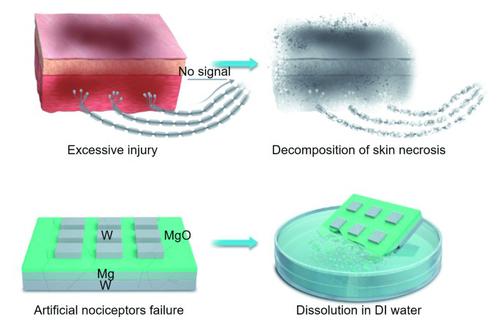Science China Materials ( IF 6.8 ) Pub Date : 2023-01-04 , DOI: 10.1007/s40843-022-2292-7 Yaxiong Cao , Saisai Wang , Rui Wang , Yuhan Xin , Yaqian Peng , Jing Sun , Mei Yang , Xiaohua Ma , Ling Lv , Hong Wang , Yue Hao

|
As an important receptor located in the skin, a nociceptor is capable of detecting noxious stimuli and sending warning signals to the central nervous system to avoid tissue damage, thus inspiring the development of artificial nociceptors for electronic receptors. Recently, memristors have attracted increasing attention for developing artificial nociceptors due to the simplicity of the artificial nociceptive system. However, the realization of artificial nociceptors with biocompatibility and biodegradability in a single memristive device remains a challenge. Herein, a fully biocompatible and biodegradable threshold switching (TS) memristor consisting of W/MgO/Mg/W configuration was proposed as an artificial nociceptor. The device showed unidirectional TS characteristics with stable electrical performance under bending conditions. Critical nociceptor behaviors, including threshold, relaxation, no adaptation, allodynia, and hyperalgesia, were successfully demonstrated in the memristive nociceptor. Meanwhile, an optoelectronic nociceptor system was built by the integration of a photoresistor and the memristor. Importantly, the devices transferred on a biodegradable polyvinyl acetate substrate as physically transient electronics could completely dissolve in deionized water, simulating the decomposition of skin necrosis. This study provides a novel route toward developing fully biocompatible and biodegradable artificial nociceptors for promising applications in implantable and wearable electronics and secure bio-integrated systems.
中文翻译:

基于 Mg/MgO 阈值开关忆阻器的可生物降解柔性人工伤害感受器
作为位于皮肤中的重要受体,伤害感受器能够检测伤害性刺激并向中枢神经系统发送警告信号以避免组织损伤,从而激发了用于电子感受器的人工伤害感受器的开发。最近,由于人工伤害感受系统的简单性,忆阻器在开发人工伤害感受器方面越来越受到关注。然而,在单个忆阻装置中实现具有生物相容性和生物降解性的人工伤害感受器仍然是一个挑战。在此,提出了一种由 W/MgO/Mg/W 配置组成的完全生物相容且可生物降解的阈值开关 (TS) 忆阻器作为人工伤害感受器。该器件表现出单向 TS 特性,在弯曲条件下具有稳定的电气性能。关键伤害感受器行为,包括阈值、松弛、无适应、异常性疼痛和痛觉过敏,已在忆阻伤害感受器中成功展示。同时,通过光敏电阻和忆阻器的集成构建了光电伤害感受器系统。重要的是,转移到可生物降解的聚乙酸乙烯酯基板上的设备作为物理瞬态电子可以完全溶解在去离子水中,模拟皮肤坏死的分解。这项研究为开发完全生物相容和可生物降解的人工伤害感受器提供了一条新途径,可用于可植入和可穿戴电子产品以及安全的生物集成系统。同时,通过光敏电阻和忆阻器的集成构建了光电伤害感受器系统。重要的是,转移到可生物降解的聚乙酸乙烯酯基板上的设备作为物理瞬态电子可以完全溶解在去离子水中,模拟皮肤坏死的分解。这项研究为开发完全生物相容和可生物降解的人工伤害感受器提供了一条新途径,可用于可植入和可穿戴电子产品以及安全的生物集成系统。同时,通过光敏电阻和忆阻器的集成构建了光电伤害感受器系统。重要的是,转移到可生物降解的聚乙酸乙烯酯基板上的设备作为物理瞬态电子可以完全溶解在去离子水中,模拟皮肤坏死的分解。这项研究为开发完全生物相容和可生物降解的人工伤害感受器提供了一条新途径,可用于可植入和可穿戴电子产品以及安全的生物集成系统。模拟皮肤坏死分解。这项研究为开发完全生物相容和可生物降解的人工伤害感受器提供了一条新途径,可用于可植入和可穿戴电子产品以及安全的生物集成系统。模拟皮肤坏死分解。这项研究为开发完全生物相容和可生物降解的人工伤害感受器提供了一条新途径,可用于可植入和可穿戴电子产品以及安全的生物集成系统。













































 京公网安备 11010802027423号
京公网安备 11010802027423号